Physical Address
304 North Cardinal St.
Dorchester Center, MA 02124
Neuroendovascular therapies consist of minimally invasive, catheter-based interventions for disorders affecting blood vessels (arteries and veins) of the brain and spine that are performed from within the vessel. For the past decade, the field of neuroendovascular therapies has been characterized by continuous and substantial growth through transformative technological advancements and multidisciplinary collaboration. Previously inaccessible lesions have become treatable with minimally invasive techniques; abnormalities that were once deemed too complex for standard endovascular therapies are now treated with new-generation devices. In parallel with technological advances, increased operator experience has improved safety and efficacy. Although basic neuroangiography techniques such as cerebral angiography were developed by the Portuguese neurologist Egaz Moniz, the majority of developments within the field of therapeutic neuroendovascular procedures have occurred over the past three decades. Digital subtraction angiography and flat-panel fluoroscopy systems have led to improved imaging capabilities and allow characterization of vascular anatomy with exquisite detail. Imaging of the parenchymal tissue has also become feasible in the neuroangiography suite through the use of cone-beam computed tomography (CT) technology. The introduction of the detachable platinum coil for aneurysm represents a paradigm shift in aneurysm treatment by introducing a minimally invasive treatment option to open surgical treatments that were hitherto not amenable to endovascular approaches. Following this landmark moment, endovascular therapy for aneurysms has continued to evolve at breathtaking pace as stent, balloon, flow-diverter, and more recently, intrasaccular devices have emerged with safer, faster, and more effective results. However, the most disruptive effect on the field was brought by the advent of technologies allowing endovascular treatment for acute ischemic stroke due to proximal large vessel occlusion with high rates of effective reperfusion that have been shown to translate into unprecedented clinical benefit when tested in multiple randomized clinical trials enrolling patients up to 24 hours after last seen well. Revascularization strategies for moderate to severe carotid stenosis consisting of carotid angioplasty and stenting (CAS) typically with the aid of embolic protection devices and the development of intracranial angioplasty and stenting have expanded treatment options for cerebrovascular conditions caused by atherosclerotic disease. Embolization techniques and new liquid embolic agents have expanded the role of neurointervention through embolization methods for arteriovenous malformations (AVMs), tumors, and chronic subdural hematomas (SDHs). Potential future approaches such as intraarterial (IA) of chemotherapy, IA stem cells, implantable stents for neuromonitoring ( ), and endovascular cerebrospinal fluid (CSF) shunts ( ) may further expand the landscape of neuroendovascular therapies.
Stroke is the fourth leading cause of death and the most common reason for disability worldwide ( ). The majority of ischemic strokes result from vessel occlusion secondary to thromboembolic or atheromatous processes. Timely reperfusion of ischemic brain tissue is the most effective therapeutic strategy. Time-based intravenous (IV) thrombolysis was initially restricted to a narrow 3-hour time window based on the NINDS trials ( ) and subsequently extended in clinical practice (although not approved by the US Food and Drug Administration [FDA]) based on the Third European Cooperative Acute Stroke Study demonstrating a smaller but definite benefit of IV thrombolysis in the 3–4.5 hours after symptom onset ( ). Recent studies have shown when physiological data derived from advanced imaging studies (magnetic resonance imaging [MRI] or CT perfusion imaging) capable of identifying the presence of mismatch between the infarcted territory relative to the entire “at-risk” territory supplied by the occluded vessel, a small benefit of IV tissue plasminogen activator (tPA) could be demonstrated up to 9 hours from last seen well ( ). Another approach ( ) using specific MRI diffusion-weighted imaging (DWI)–fluid-attenuated inversion recovery (FLAIR) mismatch signatures as a surrogate for time also demonstrated benefit of IV thrombolysis. Nonetheless, the main restrictions on IV recombinant tissue plasminogen activator (rtPA) remain the relatively narrow time window, limited effect on proximal arterial occlusions, need for advanced imaging in later time windows, and its nontargeted systemic mode of delivery. Coupled with a relative lack of public awareness, these factors have limited the use of IV thrombolysis to less than 5% of eligible candidates ( ). To improve reperfusion, many techniques have evolved, including adjunctive focused ultrasound therapy in IV rtPA and endovascular catheter-based therapies.
In 2015, five randomized clinical trials demonstrated benefit of endovascular thrombectomy compared with medical management for patients with acute ischemic stroke due to large vessel occlusion presenting in the 6–12-hour time window (Berkhemer et al., 2015, Campbell et al., 2015, Goyal et al., 2015, Jovin et al., 2015, Saver et al., 2015). Although some of these trials used time windows of up to 12 hours, the vast majority of patients enrolled were randomized within 6 hours of time last seen well. These findings were further supported by two other completed randomized trials conducted in the early time window: THRACE (Trial and Cost Effectiveness Evaluation of Intra-Arterial Thrombectomy in Acute Ischemic Stroke) (Bracard, 2016) and RESILIENT (EndoVascular Treatment with Stent-retriever and/or Thromboaspiration vs. Best Medical Therapy in Acute Ischemic Stroke) (Martins, 2019). The landmark DAWN (DWI or CT perfusion (CTP) assessment with Clinical Mismatch in the Triage of Wake-Up and Late Presenting Strokes undergoing Neurointervention) and DEFUSE 3 (Endovascular Therapy Following Imaging Evaluation for Ischemic Stroke 3) trials demonstrated the benefit of thrombectomy in patients presenting beyond 6 hours and up to the 24 hours from last seen well, which represents a change in paradigm for acute stroke care worldwide (Nogueira, 2018, Albers et al., 2018). Patients who, based on time constraints, were previously not considered candidate for thrombectomy, are now being evaluated for the presence of vessel occlusion and presence of salvageable brain up to 24 hours from last seen well as standard of care. Although inclusion criteria varied across the several randomized endovascular acute stroke trials, adequate patient selection to avoid both overtreatment and undertreatment is critical. From a pathophysiological perspective, what explains the clinical benefit seen with reperfusion therapies in acute stroke due to large vessel occlusions is the concept of mismatch between tissue that is already infarcted (ischemic core) and the entire tissue at risk of undergoing infarction. Subtracting the former from the latter yields tissue that is functionally impaired and imminently threatened to undergo infarction due to ongoing hypoperfusion but is structurally intact and thus potentially salvageable (penumbra). It is believed that the larger the mismatch, the stronger the clinical benefit with reperfusion. Consequently, selection algorithms are determined not only by clinical but also by imaging criteria and time of symptom onset determines risk/benefit stratification. Parenchymal imaging with CT or MRI is used to quantify infarct size and assess for presence of hemorrhage. CT angiography (CTA), MR angiography (MRA), or catheter angiography are used to confirm large vessel occlusion, whereas CT and MRI perfusion imaging can assess potentially salvageable tissue in the ischemic penumbra. Because the extent of neurological deficit measured by the National Institutes of Health Stroke Scale (NIHSS) is a rough estimate of the extent of tissue at risk, it can be used in conjunction with imaging-based assessment of ischemic core to assess for the presence of mismatch ( Box 54.1 ). The constellation of clinical deficit that is out of proportion to the size of the infarct observed on imaging is indicative of mismatch and is predictive of benefit with reperfusion therapies (clinical-infarct mismatch) (Dávalos et al., 2004).
Level of consciousness (0–3)
Month/age (0–2)
Commands eyes open/closed (0–2)
Best gaze (0–2)
Visual (0–3)
Facial palsy (0–3)
Best motor arm (0–4)
Best motor leg (0–4)
Limb ataxia (0–2)
Sensory (0–2)
Best language (0–3)
Dysarthria (0–2)
Neglect (0–2)
Normal/near normal examination (0–1)
Minor stroke (1–4)
Moderate stroke (5–15)
Moderate/severe stroke (15–20)
Severe stroke (>20)
Compared with IV approaches, IA administration of thrombolytics via a microcatheter positioned in the cerebral vasculature affords rapid local delivery of greater therapeutic treatment concentrations to the vascular occlusion site. The technique entails performing a catheter-based cerebral angiogram to confirm the point of occlusion. Under fluoroscopic guidance, a microcatheter is advanced through a larger guide catheter to the clot. Once positioned, a thrombolytic agent is injected as intermittent control angiograms are performed. Recanalization of the occluded vessel is then evaluated using an established scoring method such as the Treatment in Cerebral Ischemia (TICI) method ( ).
Clinical studies have been performed using streptokinase, urokinase, rtPA, recombinant prourokinase, and reteplase. These agents differ in fibrin selectivity, stability, half-life, and mechanism of action ( ). The Prolyse in Acute Cerebral Thromboembolism II (PROACT II) trial demonstrated the effectiveness of IA prourokinase when given within 6 hours of acute stroke caused by middle cerebral artery occlusion ( ). Patients were randomized to IA recombinant prourokinase and IV heparin or heparin alone. The primary clinical outcome of minimal or no disability at 90 days (modified Rankin Scale [mRS] score ≤2) was achieved in 40% of the treatment group and 25% of the controls. The Middle Cerebral Artery Embolism Local Fibrinolytic Intervention Trial (MELT) Japan randomized 114 acute stroke patients with M1/M2 occlusion into control treatment versus IA urokinase within 6 hours of symptoms onset ( ). The primary clinical outcome of mRS of 2 or less at 90 days was achieved in 49.1% of the treatment group and 38.6% of the controls.
The Interventional Management of Stroke (IMS) study investigators compared acute stroke patients treated with a bridging IV rtPA dose (0.6 mg/kg) followed by IA rtPA, with historical controls given only the traditional IV dosing regimen from the NINDS trial. The IMS I study was an open-label, single-arm, feasibility study using a microcatheter to infuse up to 22 mg of IA rtPA over 2 hours ( ). The prospective randomized IMS III trial using early-generation IA treatment methods including IA t-PA, and ultrasound-enhanced local thrombolysis with the use of the EKOS MicroLysUS (EKOS Corp., Bothell, WA) microinfusion catheter, which incorporates sonographic technology to increase permeability and penetration of the intraluminal clot ( ), and first-generation thrombectomy devices was stopped for futility and showed no significant difference in functional independence between combined IV/IA therapy as compared with IV tPA; however, similar safety outcomes were demonstrated ( ). Future research on the role of IA thrombolysis in the era of new-generation mechanical thrombectomy devices is needed ( ).
Narrow time windows, limited efficacy, and the risk of hemorrhage associated with thrombolytic agents prompted the design and application of mechanical thrombectomy devices. Endovascular clot retrieval provides potential for rapid flow restoration, with a decreased incidence of clot fragmentation and distal embolism ( ). Catheter-based, retrieval/aspiration systems began to be used in acute stroke patients who were either ineligible for or had failed IV rtPA administration; initially they were used in conjunction with thrombolytic infusion.
The first device to have received FDA approval for clot retrieval was the Mechanical Embolus Removal in Cerebral Ischemia (MERCI) device (Concentric Medical Inc., Mountain View, CA). The retriever is a flexible tapered nitinol wire with radiopaque helical loops at the distal tip ( Fig. 54.1 ). Results from the single-arm MERCI and Multi MERCI trial demonstrated the efficacy of the MERCI system in restoring the patency of occluded intracranial vessels within 8 hours of acute ischemic stroke ( ). Although no control group was available for comparison, safety and efficacy data compared with historical controls were encouraging. Some 48% of occluded vessels were recanalized, a rate significantly higher than that of the control arm in the PROACT II trial (18%) ( ). After adjuvant therapy (IA rtPA, angioplasty, snare), the rate of recanalization was 60.3%. The overall rates of good outcome (mRS score ≤2) and mortality were 27.7% and 43.5%, respectively, with a procedural complication rate of 7.1%. Furthermore, successful revascularization was found to be an independent predictor of decreased mortality and favorable neurological outcome at 90 days. Similar results were noted in the Multi MERCI trial, which included patients treated with IV tPA prior to thrombectomy and used a modified version of the original MERCI device. These trials are of historical importance because the MERCI device has been discontinued.
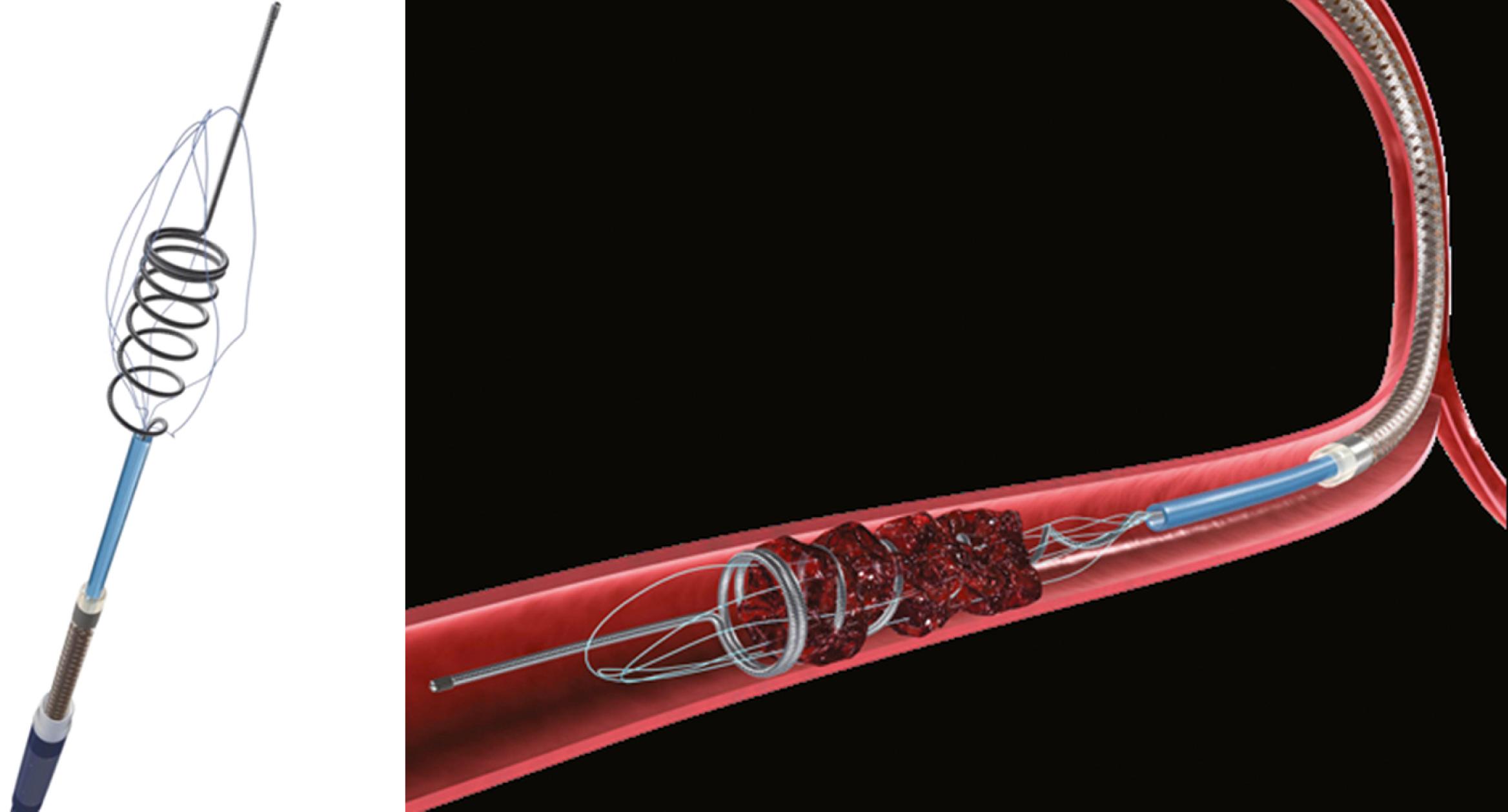
The Penumbra System (Penumbra Inc., Alameda, CA) was the first aspiration device through which a thromboembolic clot could be retrieved following acute ischemic stroke ( Fig. 54.2 ). The device removes thrombus via aspiration and extraction with or without mechanical disruption. Multiple aspiration catheters of varying luminal diameters are available for use in the cervical and intracranial vasculature, depending on vessel caliber. The aspiration device is advanced coaxially to the level of the thrombus through a guide catheter. When positioned immediately proximal to the target lesion, an aspiration pump is connected to the reperfusion catheter or manual aspiration is applied. The separator is then advanced through the catheter into the distal clot and repeatedly retracted and advanced, to clear the catheter tip during aspiration ( Fig. 54.3 ). A multicenter, prospective, single-arm, phase I trial of the Penumbra reperfusion catheter was designed to assess safety and efficacy ( ). Recanalization (Thrombolysis in Myocardial Infarction [TIMI] score of 2 or 3) was achieved in all vessels in which the device was deployed. A secondary endpoint of mRS score of 2 or less or improvement of NIHSS score by 4 or better was achieved in 45% of patients. The Penumbra device received FDA approval in 2008, and since then newer-generation large-bore reperfusion catheters have been introduced to allow improved aspiration of the clot. The separator clot disruption device has since been abandoned.
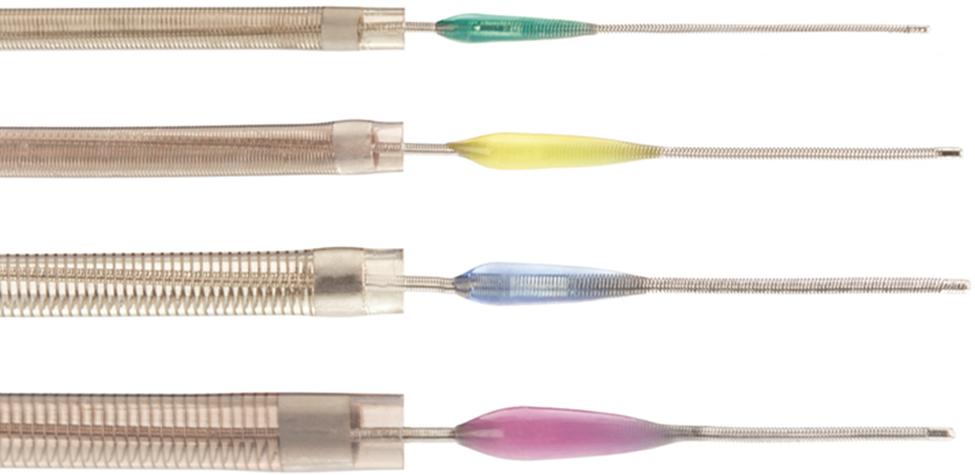
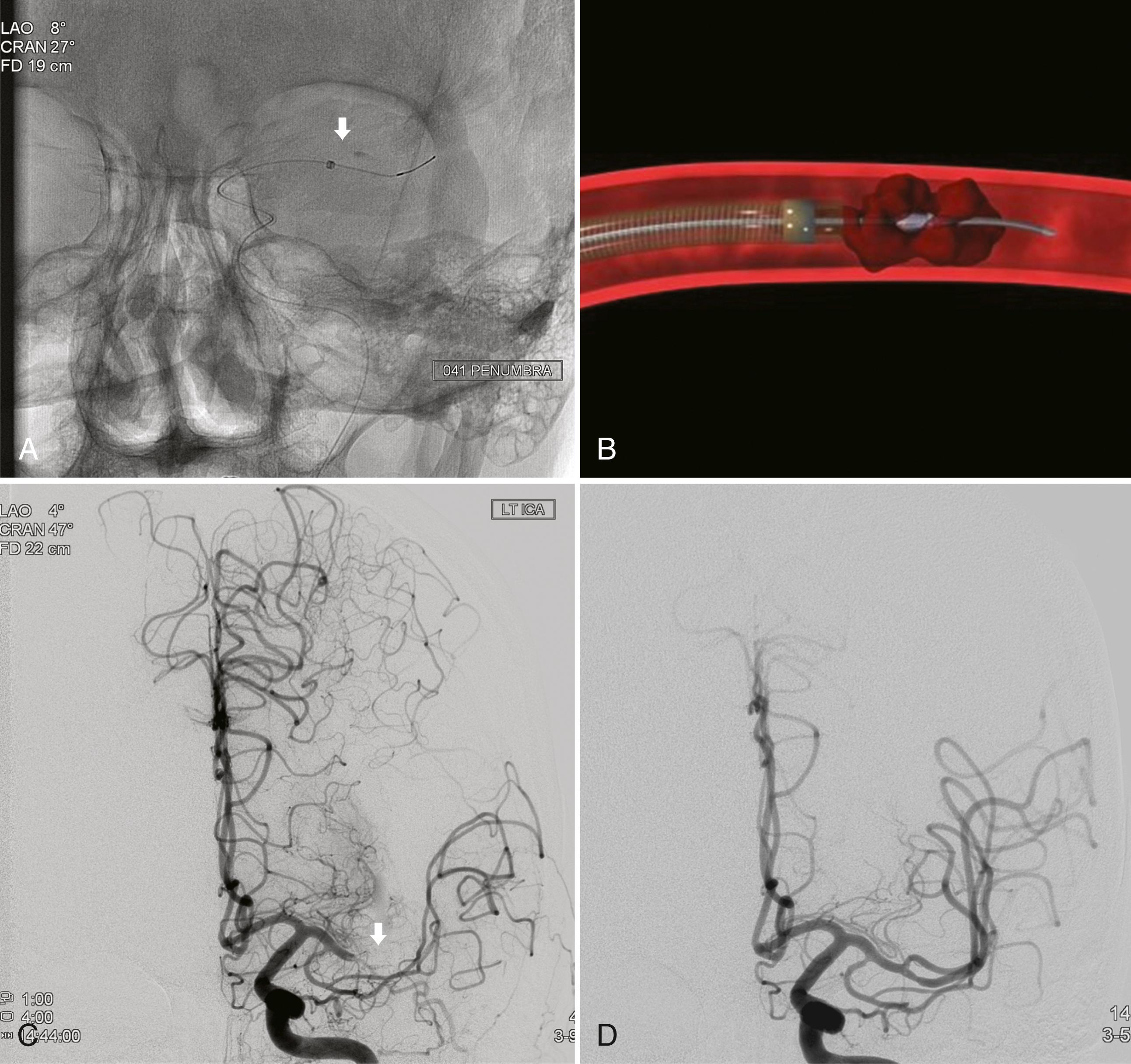
The Contact Aspiration vs Stent Retriever for Successful Revascularization (ASTER) and the COMPASS (A Direct Aspiration First Pass Technique) trial were two multicenter randomized trials comparing aspiration thrombectomy versus stent retriever thrombectomy as first-line approaches for large vessel occlusion ( ). Patients with large vessel occlusion presenting within 6 hours of symptom onset were randomly assigned to a first-line strategy consisting of either direct aspiration or stent retriever. Both studies showed that direct or contact aspiration first pass was not inferior to stent retriever as first-line therapy ( ).
Retrievable stent devices designed to retrieve the occlusive thrombus emerged as favorable methods for acute stroke thrombectomy ( Fig. 54.4 ) after two such devices in a head to head head-to-head comparison against the MERCI device showed superior rates of recanalization and better clinical outcomes (Saver et al., 2012, Nogueiraa). Both the Solitaire FR (Medtronic, Irvine, CA) and Trevo Retriever (Stryker Neurovascular) devices subsequently received FDA approval. Subsequently, a third stent retriever, EmboTraP (Cerenovus, Miami, Fl), was approved by the FDA following the 228 patient clinical trial (ARISE II: Analysis of Revascularization in Ischemic Stroke with EmboTrap) demonstrating TICI ≥2b rate of 80% and mRS 0–2 of 67% at 90 days ( ).
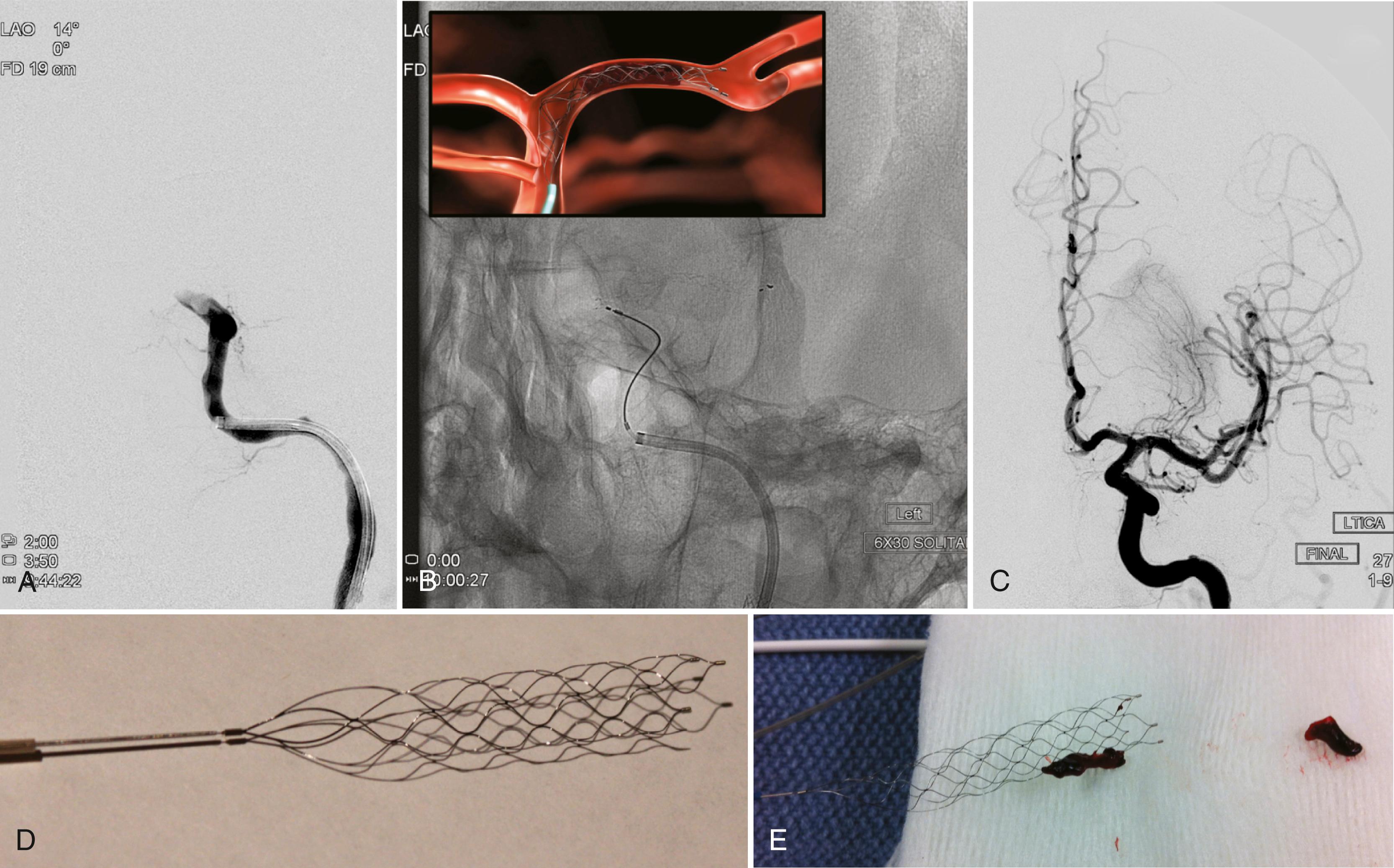
In the wake of the negative IMS 3 and MR RESCUE (Mechanical Retrieval and Recanalization of Stroke Clots Using Embolectomy) trials, the higher rates of recanalization observed with newer-generation devices, particularly with stent retrievers, prompted an international effort to reappraise the benefit of thrombectomy in a new era of endovascular stroke therapy. Nine completed randomized trials revealed overwhelming efficacy for acute ischemic stroke thrombectomy for large vessel occlusion in early and extended time windows.
The Multicenter Randomized CLinical trial of Endovascular treatment for Acute ischemic stroke in the Netherlands (MR CLEAN) study was a randomized clinical trial in acute ischemic stroke patients with large vessel occlusion ( ). Patients were randomized to best medical management with or without IA therapy using the new class of mechanical thrombectomy devices (retrievable stent) within 6 hours of symptom onset. Patients were eligible with NIHSS score of as low as 2 and a large vessel occlusion on the head CT angiogram; however, the median NIHSS of patients enrolled in this trial was 17. The trial demonstrated positive outcome in favor of IA therapy over best medical management alone.
After the release of the MR CLEAN trial results at the World Stroke Congress in 2014, all subsequent mechanical thrombectomy randomized trials in the early time windows with the exception of RESILIENT were stopped due to potential lack of equipoise for continued enrollment.
An individual-level meta-analysis comprising 1287 patients enrolled in MR CLEAN, SWIFT PRIME (Solitaire with the Intention for Thrombectomy as PRIMary Endovascular Treatment), ESCAPE (Endovascular Treatment for Small Core and Proximal Occlusion Ischemic Stroke), EXTEND IA (Extending the Time for Thrombolysis in Emergency Neurological Deficits- Intra-Arterial), and REVASCAT (Extending the Time for Thrombolysis in Emergency Neurological Deficits- Intra-Arterial) confirmed the overwhelming benefit of endovascular therapy for stroke, translating into a number needed to treat (NNT) of 3 to reduce poststroke disability. Patients allocated to thrombectomy achieved a modified Rankin Score of 0–2 (signifying independence in activities of daily living) in a significantly higher proportion than patients allocated to medical therapy (which in the vast majority of cases included IV tPA) (291/633–42% vs. 171/645–26.5%, respectively, P < .00001). The rates of symptomatic intracerebral hemorrhage did not differ significantly between the two groups (4.4% vs. 4.3%, respectively) and neither did the rates of mortality (15.3% vs. 18.9%).
Prior to the publication of DAWN, no evidence existed with regards to clinical benefit in patients presenting later than 6 hours from time last known well, with evidence of proximal large vessel occlusion and substantial mismatch. Available data suggest that these patients may comprise approximately 30% of all patients with acute stroke due to proximal large vessel occlusion ( ) and thus represent a significant proportion of patients potentially eligible for thrombectomy. The DAWN trial was a randomized trial of patients with occlusion of the internal carotid artery (ICA) or proximal middle cerebral artery who could be randomized 6–24 hours from the time last seen well and with mismatch between the severity of the clinical deficit (NIHSS) and infarct volume assessed by means of automated software based on CT perfusion or MRI (clinical infarct mismatch). Patients were randomized to thrombectomy with the Trevo device in addition to standard of care versus standard of care alone largely consisting of antiplatelet therapy and general supportive care for stroke in the ICU setting. The primary endpoints were the mean score for disability on the utility-weighted mRS and the rate of functional independence. The trial was stopped prematurely due to an interim analysis that allowed stopping based on efficacy yielded results that met prespecified endpoints. Favorable clinical outcome as defined by mRS ≤2 was achieved more often in patients who underwent thrombectomy compared with medical management (49% vs. 13%, 95% confidence interval [CI] 24%–44%). There were no safety concerns. There were no differences in the rates of symptomatic intracranial hemorrhage (6% vs. 3%, P = .5) or 90-day mortality (19% vs. 18%, P = 1) between the thrombectomy and control groups, respectively ( ).
The release of the DAWN trial results prompted an interim analysis by the DEFUSE 3 investigators. DEFUSE 3 was a randomized trial comparing patients with proximal large vessel occlusion and mismatch as determined by CT perfusion or MRI, treated with best medical management or mechanical thrombectomy. Key inclusion criteria included NIHSS 6 or greater, middle cerebral artery or ICA occlusion, and symptom randomization between 6 and 16 hours from time last seen well. Patients were selected based on an imaging profile demonstrating an infarct volume of less than 70 mL assessed by DWI MRI or CT perfusion and ratio of volume of ischemic tissue at risk (assessed by MR or CT perfusion as <30% contralateral cerebral blood flow [CBF]) to infarcted tissue ratio of 1.8. Similar to DAWN, DEFUSE 3 demonstrated better outcomes for patients treated with thrombectomy compared with standard medical management (mRS 0–2; 45% vs. 17%, P < .001). An individual-level pooled analysis of patients from DAWN, DEFUSE 3, and other three trials that randomized patients beyond 6 hours from symptoms onset revealed no increased incidence in symptomatic intracranial hemorrhage (sICH) between treatment and control and a treatment effect that is equivalent to that seen in patients randomized in the early time window (adjusted odds ratio [OR] for the distribution of mRS treatment vs. control of 2.77 (95% CI 1.95–3.94), P < .0001) vs. 2.49 (95% CI 1.76–3.53), P < .0001, respectively ( ).
Two retrospective multicenter registries, TRACK (The TREVO Stent-Retriever Acute Stroke [TRACK] Registry) and North American Solitaire Acute Stroke Registry (NASA), demonstrated good clinical outcome with the stent retriever in real world clinical practice with favorable reperfusion rates of 80% and 88%, respectively; good clinical outcome defined as modified Rankin score 2 or less was seen in 48% and 42%, respectively (Zaidat et al., 2014 ). The NASA study also coined the notion of first pass effect, defined as achieving complete recanalization with a single thrombectomy device pass ( ). In the NASA study, later confirmed by other thrombectomy studies ( ), first-pass effect was found to be significantly associated with better clinical outcome.
The clinical effectiveness of thrombectomy has been more recently confirmed by two large prospective registries. The Systematic Evaluation of Patients Treated with Stroke Devices for Acute Ischemic Stroke (STRATIS) registry enrolled 984 patients (mean NIHSS 17.3; IV tPA use 64%) with large vessel occlusion strokes who were treated with the Solitaire or Mindframe Capture devices (Medtronic, Irvine, CA) within 8 hours from stroke onset at 55 US sites. The rates of successful reperfusion (TICI ≥ 2b), SICH, 90-day good outcome (mRS 0–2), and mortality were 87.9%, 1.4%, 56.5%, and 14.4%, respectively ( ). The Trevo Registry recruited 2008 acute ischemic stroke patients (mean NIHSS 15.5; IV tPA use 52.3%) across 76 centers in 12 countries. Unlike STRATIS, the Trevo registry had no limits in terms of baseline stroke severity, premorbid mRS, occlusion site, or duration of symptoms. The rates of successful reperfusion (TICI ≥ 2b), SICH, 90-day good outcome (mRS 0–2), and mortality were 92.8%, 1.7%, 55.3%, and 13.9%, respectively ( ).
Subanalysis of the NASA registry evaluated the role of the balloon guide catheter in reperfusion for patients treated with the Solitaire stent retriever. The balloon guide catheter is a catheter placed at the cervical carotid or vertebral artery. Once the clot is ready for retrieval, the balloon mounted on the outside of the catheter is inflated to arrest antegrade flow as the clot is retrieved with concomitant aspiration at the guide catheter. In multiple nonrandomized registries, the use of the balloon guide catheter was associated with improved reperfusion and clinical outcome compared with patients who were treated with conventional guide catheter ( , ).
Mature fibrinous clots can be difficult to treat pharmacologically, and thrombi adherent to the vascular intima or associated with underlying atheromatous disease can present a challenge for mechanical thrombectomy. Percutaneous transluminal angioplasty (PTA) and stenting procedures have been successful in acute coronary revascularization. Recanalization with angioplasty and stenting has been used in the absence of clot dissolution or extraction ( ). Several studies reported improvement in clinical outcome following angioplasty and local thrombolytic administration in the setting of acute stroke ( ). A single-arm prospective trial of primary intracranial stenting for acute stroke demonstrated promising results. The authors reported 100% TIMI 2–3 recanalization in a cohort of 20 patients treated with intracranial stenting. Self-expanding stents (Wingspan [Boston Scientific, Natick, MA]; Enterprise [Cordis Neurovascular, Miami Lakes, FL]) designed exclusively for cerebral indications facilitated access and navigation through tortuous craniocervical anatomy. Although adjuvant IA antiplatelet therapy was used in 50% of patients, the authors reported only a 5% rate of symptomatic intracranial hemorrhage. At 1 month, 60% of patients had mRS scores of 3 or less, and 45% had mRS scores of 1 or less. These results suggest a potential role for this therapy in select acute stroke patients. Treatment for acute large vessel occlusion (LVO) stroke with balloon-mounted stents as second-line approach after failed thrombectomy in patients with presumed intracranial atherosclerotic disease (ICAD) has been shown to have reperfusion rates and clinical outcomes comparable to thrombectomy, although the rates of sICH and mortality were higher in this cohort of high-risk patients ( ). Nonetheless, the need for immediate antiplatelet agent administration to prevent stent thrombosis, with their ensuing hemorrhagic risk especially in those patients who receive IV tPA, are potential limitations of this technology. Larger randomized studies are needed, to assess the safety and efficacy of this treatment modality.
Extracranial carotid artery disease and its management have remained a long-standing focus in efforts targeting stroke prevention. Indications and outcomes for carotid endarterectomy (CEA) have been extensively studied in the setting of large-vessel extracranial steno-occlusive disease. Multicenter randomized clinical trials demonstrated that, compared with medical therapy alone, CEA in addition to aspirin reduces the incidence of stroke and death in both symptomatic and asymptomatic patients with severe carotid stenosis, with dramatic differences in treatment effect according to asymptomatic versus symptomatic status and in the latter group, according to timing of surgery.
The two landmark randomized controlled trials that enrolled symptomatic carotid stenosis patients were the North American Symptomatic Carotid Endarterectomy Trial (NASCET) and the European Carotid Surgery Trial (ECST) ( ). The NASCET investigators showed that CEA reduced the risk of ipsilateral stroke (9%) at 2 years, compared with best medical therapy (26%) in patients harboring carotid stenoses of 70%–99%. A more modest yet still significant reduction in the 5-year rate of ipsilateral stroke was evident in patients with 50%–70% stenosis ( Box 54.2 ). The overall perioperative stroke and death rate for patients treated with CEA was 5.8%. Using a different measurement criterion for quantifying luminal stenosis on angiography, the ECST arrived at a similar result. Data demonstrated that surgically treated patients with stenosis greater than 80% had a lower estimated risk of death or major stroke when compared with those managed medically. A subsequent meta-analysis that included all NASCET and ECST patients revealed that the strongest benefit from revascularization is within the first 2 weeks of the index event ( ). There is still considerable debate regarding the optimal timing of intervention within those 2 weeks. Although mounting evidence indicates that the risk of intervention is highest in the first 48 hours post index event, this does not necessarily imply that revascularization should be preferentially performed outside of this time frame when the risk of recurrent events without revascularization is also highest. There is a paucity of natural history data on the risk of recurrent stroke ultra-early after index event in patients with ipsilateral high-grade carotid stenosis. However, prospective studies have estimated that the ultra-early risk of neurological deterioration may be as high as 5%–21% within the first 48–72 hours.
Defined as having significant comorbidities and/or anatomical risk and would be poor candidates for carotid endarterectomy (CEA) in the opinion of a surgeon.
Significant comorbid conditions include but are not limited to:
Congestive heart failure class III/IV
Left ventricular ejection fraction <30%
Unstable angina
Contralateral carotid occlusion
Recent myocardial infarction
Previous CEA with recurrent stenosis
Prior radiation treatment to the neck; and
Other conditions that were used to determine patients at high risk for CEA in the prior carotid angioplasty followed by stenting (CAS) trials
The Asymptomatic Carotid Atherosclerosis Study (ACAS) and the Asymptomatic Carotid Surgery Trial (ACST) addressed indications for CEA in asymptomatic patients ( ). Both studies demonstrated that compared with those treated with best medical therapy, the 5-year incidence of ipsilateral stroke or death was reduced in the CEA group. The 5-year stroke and death rate was 11% for patients in the medical therapy cohort, while the stroke risk was 5.1% for patients treated with CEA.
Based on these results, the American Heart Association guidelines recommend CEA for symptomatic patients with 50%–99% stenosis if the perioperative risk of stroke or death is less than 6%, and for asymptomatic patients with stenosis of 60%–99% if the perioperative risk of stroke or death is less than 3% ( ).
Based on observed lower rates of ipsilateral stroke in asymptomatic patients in the era of modern medical therapy compared with those noted during ACAS and ACST, the concept of revascularization treatment (with stenting or endarterectomy) for asymptomatic carotid disease, regardless of severity is being reevaluated in the ongoing Carotid Revascularization Endarterectomy versus Stenting Trial (CREST) II trial ( ).
CAS evolved because of a need for alternative, less-invasive treatment modalities for patients deemed poor operative candidates on the basis of anatomical or clinical parameters. In addition, the less-invasive nature of the stenting procedure makes it an appealing alternative to surgery for many patients.
In anticipation of carotid artery angioplasty and stenting, dual antiplatelet therapy is initiated prior to the intervention to decrease the risk of thromboembolic complications. Most procedures are performed awake or under monitored anesthesia care, allowing for continuous neurological assessment. Placement of an embolic protection system is generally attempted, to mitigate the effects of distal embolization. Distal protection is most commonly achieved with over-the-wire distal filters sized to the diameter of the native cervical ICA that are navigated past the stenotic lesion ( Fig. 54.5 ). Such devices allow continuous cerebral perfusion through pores in the filter baskets. Following angioplasty and stenting, the device is collapsed and withdrawn and embolic material retrieved. Alternatively, proximal flow control systems such as balloon occlusion devices may be used to prevent anterograde flow within the ICA. Any displaced material can be aspirated prior to balloon deflation. However, temporary carotid occlusion may not be well tolerated in all patients, limiting the applicability of this strategy.
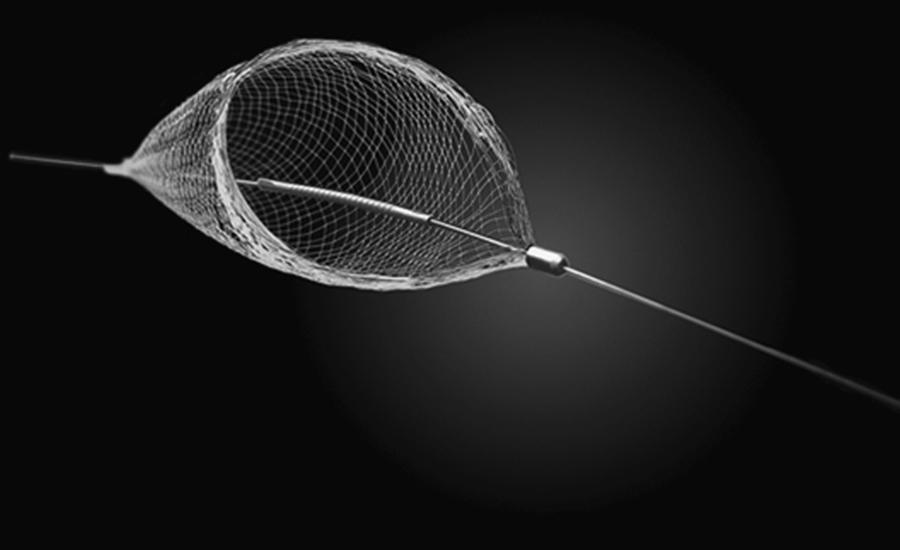
Once embolic protection is achieved, balloon pre-dilatation of tight stenoses can help ensure safe advancement of a self-expanding stent past the target lesion. Balloon inflation is done slowly to lessen the incidence of thromboembolism. Communication with an anesthesiologist is critical to address bradycardia which can occur with balloon inflation at the level of the carotid bulb, and later, to lower blood pressure after carotid revascularization to prevent reperfusion hemorrhage. Stent diameter is calibrated to the common carotid artery diameter and length is measured to traverse the entire lesion with a margin of several millimeters both proximally and distally. Tapered stents are available to accommodate the larger diameter of the common carotid artery and the smaller lumen of the ICA. Depending on residual stenosis and distal perfusion, post-stent balloon dilatation may be undertaken ( Fig. 54.6 ).
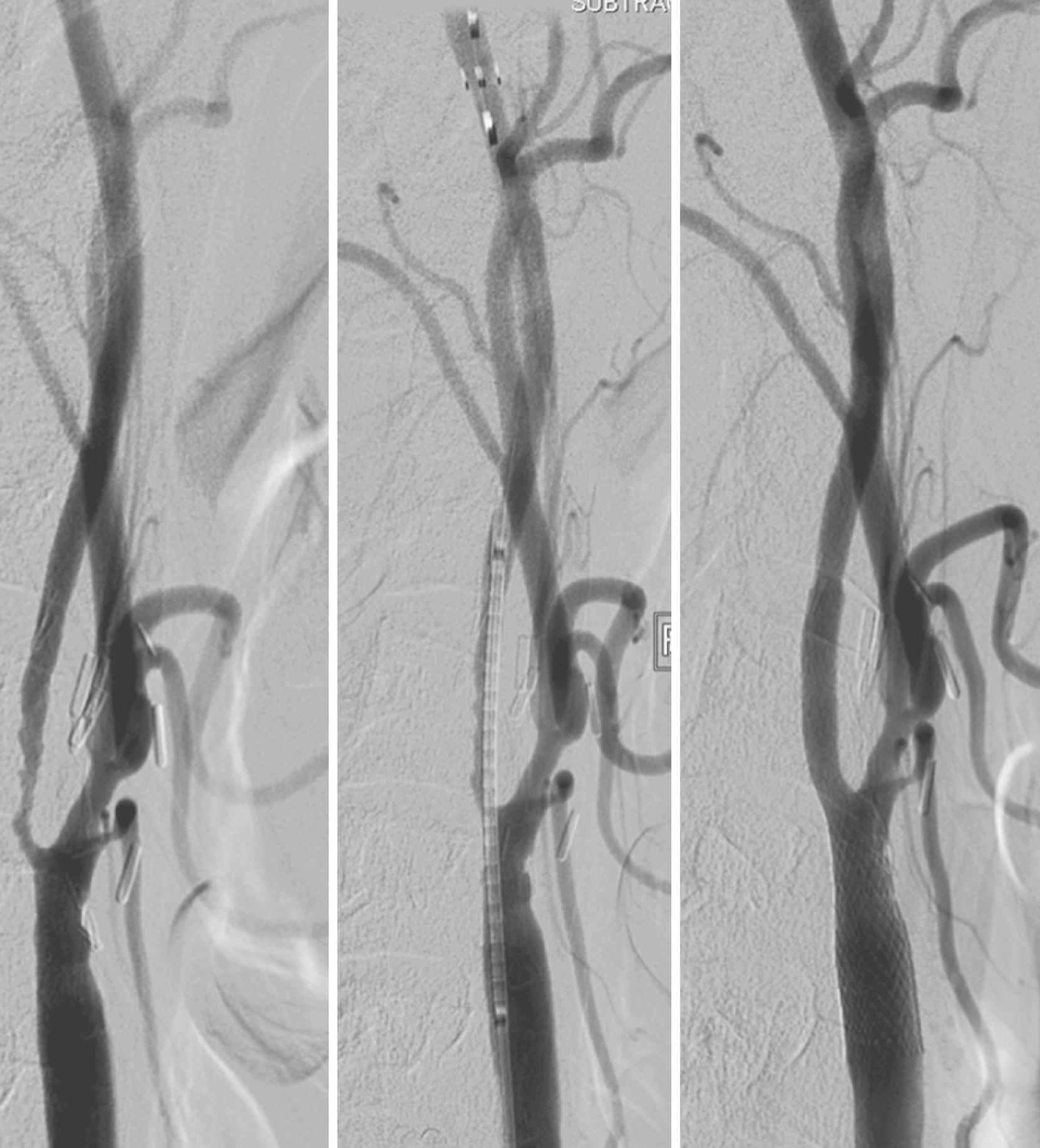
Since the advent of CAS procedures, multiple clinical trials have demonstrated that carotid stenting procedures are feasible in most patients with carotid stenosis. Over the recent 20 years the procedure has undergone a significant maturation process and most studies have attested to the decreasing incidence of adverse events with this procedure over time ( ). Studies have demonstrated benefit of CAS over CEA in high-risk surgical patients and equivalent benefits in lower-risk candidates.
The largest randomized trial conducted in North America, the prospective CREST enrolled a total of 1326 symptomatic patients with greater than 50% stenosis and 1176 asymptomatic patients with greater than 60% stenosis deemed good candidates for either CEA or CAS ( ). Primary endpoints included death, stroke, and myocardial infarction (MI) at 30 days or ipsilateral stroke at 1 year. Based on the rates of the primary endpoint achieved in each arm, (7.2% with stenting vs. 6.8% with endarterectomy) carotid artery stenting was found to be equivalent to CEA. Furthermore, both the incidence of death, MI, or stroke at 30 days and the incidence of periprocedural major (disabling) stroke were nonsignificant between the two arms (5.2% vs. 4.5%) and (0.9% vs. 0.7%), respectively. Although the overall incidence of stroke was significantly higher in the CAS arm (4.1% vs. 2.3%, P = .01), the incidence of MI was significantly lower in the CAS arm, compared with the CEA arm (1.1% vs. 2.3%, P = .03). Cranial nerve palsies were also significantly more common in the CEA arm. Long-term follow-up suggested that the incidence of ipsilateral stroke after the periprocedural period (≈4 years of follow-up) was similar between the two arms (2.0% vs. 2.4%). Subgroup analyses indicated effect modification by age such that patients 69 years of age or younger had lower rates of the primary endpoint with CAS, whereas those aged 70 or older had higher rates with CEA ( ). During the periprocedural period, rates of the primary endpoint did not differ significantly between the stenting group and the endarterectomy group among symptomatic patients (6.7% vs. 5.4%; hazard ratio [HR] for stenting, 1.26; 95% CI, 0.81–1.96) or among asymptomatic patients (3.5% vs. 3.6%; HR, 1.02; 95% CI, 0.55–1.86). These results have justified expansion of indications for CAS procedures to include non–high-risk patients.
The International Carotid Stenting Study (ICSS), also known as CAVATAS II , is a European trial in symptomatic carotid stenosis patients. It was designed to revisit the questions raised in the original investigation while using stents in all percutaneous procedures (CAVATAS, 2001; ). Initial results were published at the same time the CREST data were revealed. ICSS enrolled 1713 patients and demonstrated that the incidence of stroke, death, or procedural MI was significantly elevated in the stenting group (8.5%) compared with the endarterectomy group (5.2%). There was an increased number of cranial nerve palsies in the CEA group.
The conflicting initial results generated by the CREST study, which was performed in the United States, and the European ICSS trial raised further questions regarding the indications for these two procedures. However, it must be noted that the studies were designed differently. Although CREST evaluated both symptomatic and asymptomatic patients, ICSS examined only those with symptoms. Furthermore, as perhaps the most significant difference between the two trials, ICSS allowed participation of less experienced operators compared with CREST with no “lead-in time” allowed into the trial.
Equivalence between CAS and CEA based on the CREST cohort was reported at 10 years results ( ). and noninferiority of CAS compared with CEA has been demonstrated in the randomized asymptomatic ACST trial, further supporting the use of CAS as a viable alternative to CEA along the wide spectrum of carotid stenosis patients, who based on anatomical and clinical grounds are deemed suitable for stenting.
The Carotid Revascularization and Medical Management for Asymptomatic Carotid Stenosis Trial (CREST-2) is an ongoing trial which will assess whether CEA or CAS, in addition to intensive medical therapy, is superior to intensive medical therapy alone in the primary prevention of stroke in patients with high-grade asymptomatic carotid stenosis ( ). There are two components to CREST-2. One trial compares CEA to intensive medical therapy versus intensive medical therapy alone. The other trial compares carotid stenting in addition to intensive medical therapy versus intensive medical therapy alone. CAS and CEA are not compared against each other in CREST. Of note, the effects of carotid revascularization on cognition will also be evaluated ( ).
ICAD is a common etiology of cerebrovascular disease, responsible for at least 9% of all ischemic strokes ( ). The Warfarin-Aspirin Symptomatic Intracranial Disease (WASID) trial and subset analyses demonstrated that patients who had suffered an ischemic cerebrovascular event and harbored more than 70% stenosis of a referable intracranial artery were at a high risk for recurrent stroke ( ). A reported 23% of enrolled patients experienced a subsequent ipsilateral stroke over the course of the next year despite state-of-the-art medical therapy at the time the trial was conducted ( ). This high event rate occurred regardless of whether or not patients had failed antithrombotic therapy at the time of their qualifying event ( ).
The development and widespread success of angioplasty and stenting for peripheral and coronary atheromatous disease have promoted adaptation of these techniques to treat lesions in the cerebral vasculature. Modern imaging modalities and technological advancements in catheter and device design have enabled endovascular treatment of ICAD.
Balloon angioplasty was the first percutaneous transluminal technique evaluated for ICAD. In a large retrospective study reported on 120 patients with intracranial stenosis treated by primary angioplasty ( ), the periprocedural stroke and death rate was 5.8% and a total yearly event rate of 3.2%. This and other investigations have reported posttreatment residual vessel stenosis in the range of 40% ( , ). High incidences of angiographic vessel dissection have been documented, although they have rarely been noted to manifest as clinical events ( ). Durability of primary angioplasty has also been questioned, with reported retreatment rates near 20% ( ). investigated lesion-specific features that predicted successful angioplasty and low restenosis rates. They determined that short segment, concentric narrowing, and subtotal angiographic occlusion correlated with the lowest incidence of restenosis following PTA. By contrast, features that portended poor outcome or higher rates of restenosis were eccentricity, extreme angularity, length greater than 10 mm, or excessive tortuosity of the proximal vessel segment. In addition, the success rate was significantly lower for lesions treated more than 3 months from the time of stroke.
Experience in the coronary literature indicated that the shortcomings of primary angioplasty (plaque dislodgement, acute elastic recoil, vessel dissection, recurrent stenosis) could be overcome by subsequent stent deployment ( ). These concepts were translated directly to the intracranial vasculature.
Several early case reports described angioplasty and stenting of cerebral vessels using coronary artery techniques ( ). Device rigidity and vascular tortuosity rendered navigation difficult, resulting in periprocedural morbidity and mortality rates greater than those of angioplasty alone ( ). The multicenter nonrandomized Stenting in Symptomatic Atherosclerotic Lesions of Vertebral and Intracranial Arteries (SSYLVIA) trial reported the safety and efficacy of a balloon-mounted stent (Neurolink, Guidant Corporation, Indianapolis, IN) designed specifically for craniocervical application; 43 patients with symptomatic intracranial disease and 18 with extracranial vertebral artery stenoses were evaluated. Successful stent placement was achieved in 95% of patients. The investigators reported a 6.6% periprocedural stroke rate and an additional 7.3% incidence of stroke at 1-year follow-up. However, angiographic restenosis was documented in 35% of patients and was symptomatic in more than one-third of these individuals ( ). Based on these data, the FDA granted the stent a humanitarian device exemption (HDE) for the treatment of high-risk patients with significant intracranial and extracranial atherosclerotic disease who had failed medical therapy. Another study, using the Apollo intracranial balloon-mounted stent, documented a 91.7% rate of technical success (MicroPort Medical, Shanghai, China) in patients harboring stenosis greater than 50% ( ). The primary endpoint, ischemic stroke in the target lesion arterial territory or any stroke/death within 30 days, occurred at a rate of 4.3 per 100 patient-years. A restenosis rate of 28% was reported.
The Wingspan stent is the first self-expanding system designed for ICAD application ( Fig. 54.7 ). A hybrid of nickel and titanium (nitinol) metal construct allows navigation of small and tortuous intracranial vessels. The FDA granted an HDE approval for the Wingspan Stent System with Gateway PTA balloon catheter (Boston Scientific) for symptomatic ICAD referable to an intracranial vessel with greater than 50% stenosis and refractory to medical therapy. Endorsement was predicated on a safety study conducted in Europe and Asia ( ). In that initial investigation, technical success was achieved in 98% of patients, and the 6-month death or ipsilateral stroke rate was 7%, with an all-cause stroke rate of 9.7%. In the National Institute of Health (NIH) Multicenter Wingspan Intracranial Stent Registry Study, 129 patients with symptomatic 70%–99% intracranial stenosis were enrolled. The technical success rate was 97%. The frequency of any stroke, intracerebral hemorrhage, and death within 30 days or ipsilateral stroke beyond 30 days was 14% at 6 months ( ). The reported frequency of angiographic restenosis was 25%.
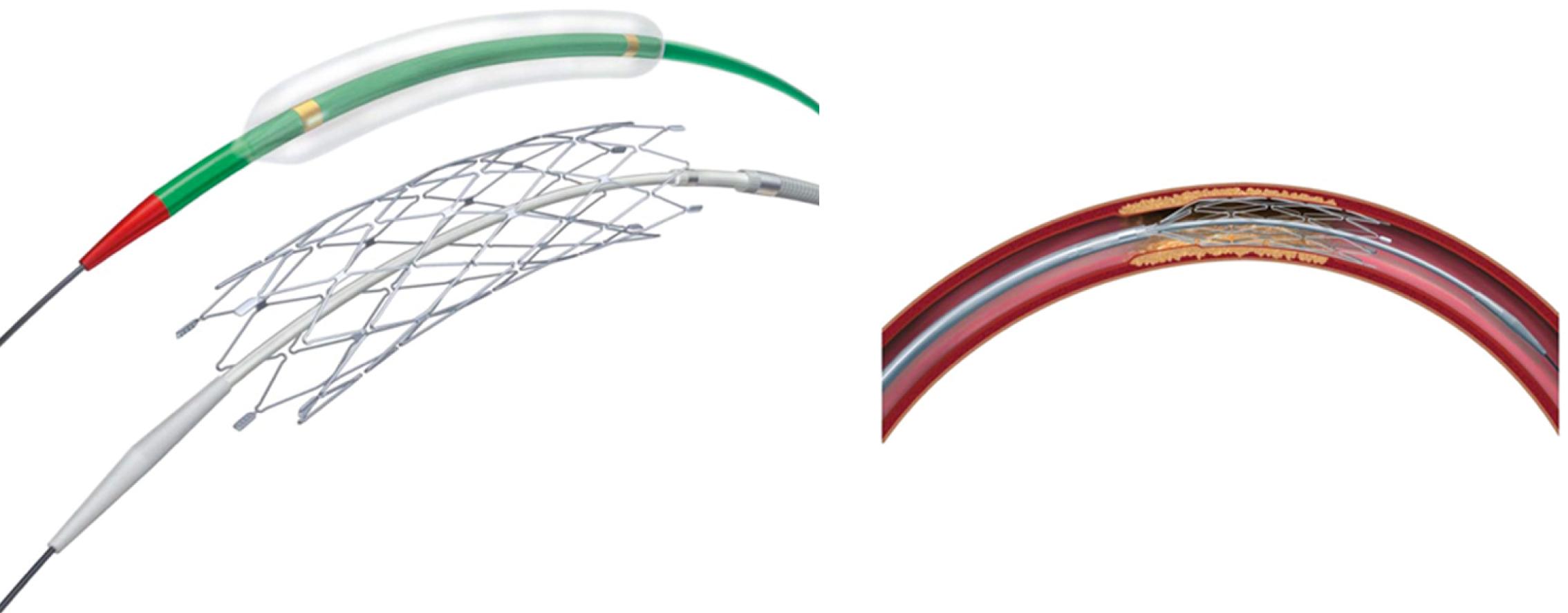
In-stent restenosis has decreased following cardiac angioplasty and stenting procedures with the advent of drug-eluting stents ( ). Although this new generation of stents has been shown to be useful in reducing neointimal hyperplasia, no platforms have been designed and approved for use in the small and tortuous intracranial vessels. However, it has been reported that placement of drug-eluting stents in the intracranial circulation is feasible, with a lower incidence of restenosis and similar safety profile compared with bare metal stents ( ).
After a microcatheter is advanced past the lesion, an exchange-length microwire is used to advance, in series, the balloon angioplasty and stent catheters to the level of stenosis. The lesion is initially dilated with a PTA balloon typically sized to 80% of the native vessel luminal diameter, using the slow inflation technique advocated by . After initial vessel dilation, the balloon catheter is exchanged for the self-expanding stent system, which is deployed across the stenotic lesion. Poststenting balloon dilation is discouraged by the manufacturer. Balloon-mounted design intracranial stents are also delivered over a wire but with the stent mounted over the balloon in a single device ( Fig. 54.8 ). Following angioplasty and stenting, with self-expanding stents, residual stenosis (30%) tends to be less than that observed following PTA alone (40%) but more severe than that noted after balloon-mounted stent deployment ( ). Follow-up angiograms have demonstrated restenosis rates exceeding 30%, presumably due to elastic recoil, neointimal hyperplasia, and vascular remodeling ( ). Coating stents with antiproliferative agents such as sirolimus has been effective in reducing restenosis rates in the cardiology literature ( ). Some studies have demonstrated encouraging results for the treatment of ICAD patients with drug-eluting stents ( ).
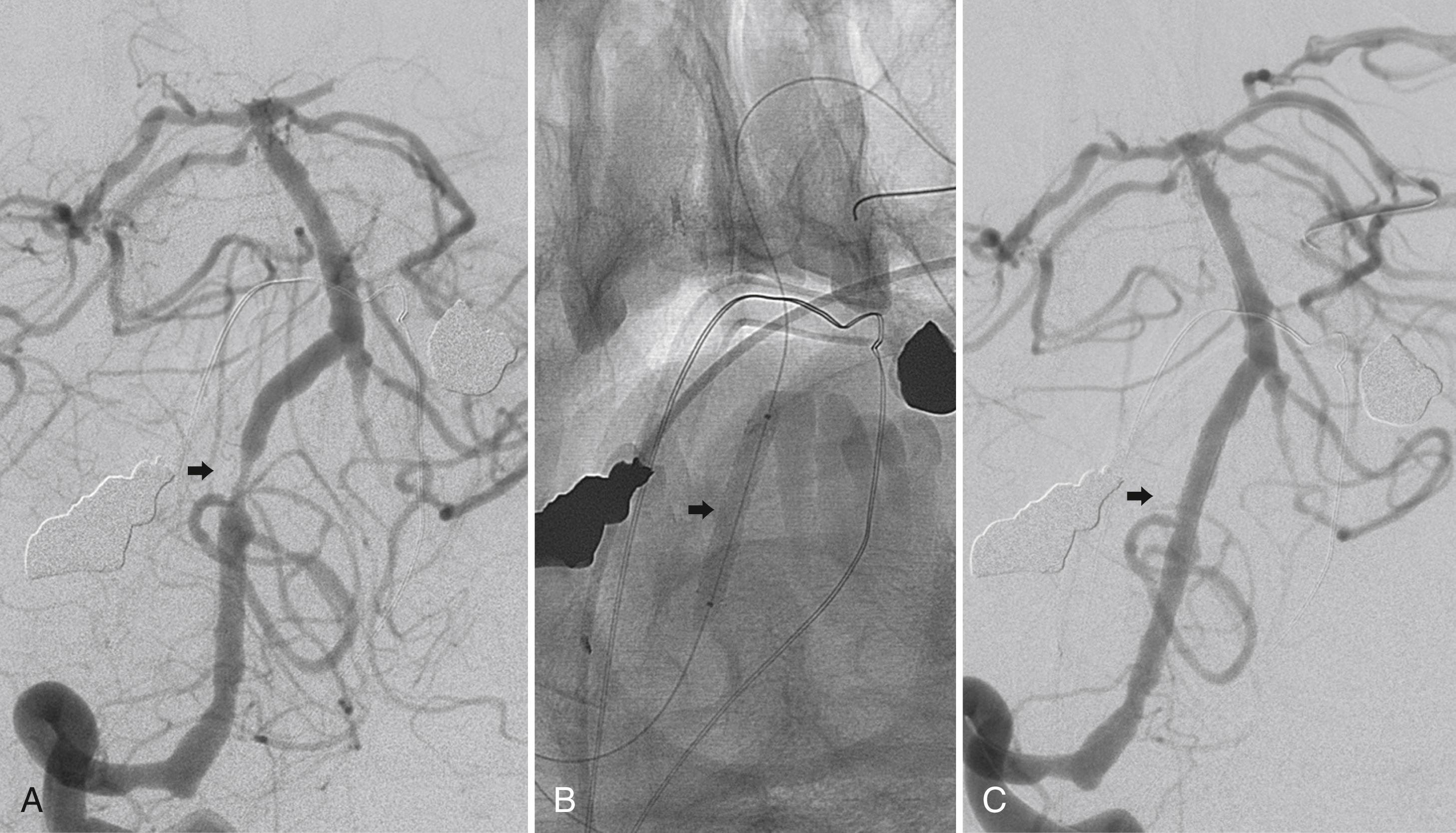
Become a Clinical Tree membership for Full access and enjoy Unlimited articles
If you are a member. Log in here